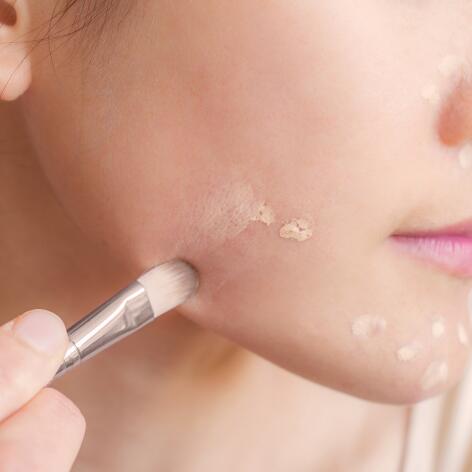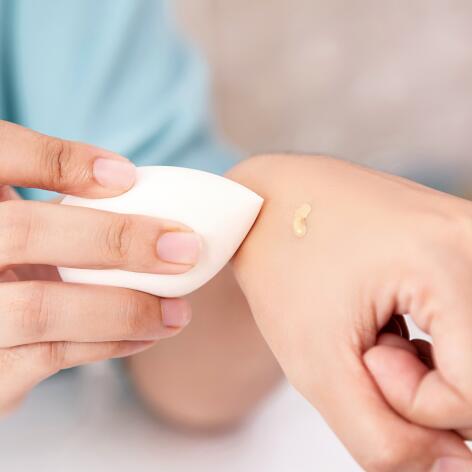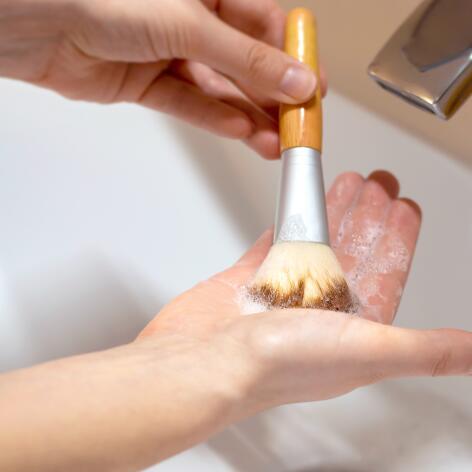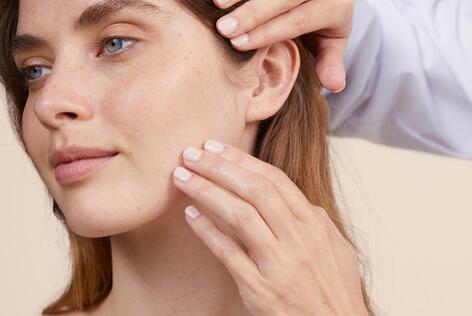Applying make-up to oily skin
Applying make-up to oily skin
An overproduction of sebum makes the skin oily and it can be difficult to apply make-up. Whether the problem is localised to the T-zone or affects the whole face, there are solutions and good daily habits you can adopt to keep foundation and powder in place easily.
Prepare your skin for make-up
To prepare your skin for make-up, start by cleansing it with a micellar water or cleansing gel. This first step eliminates sebum produced during the night. For more luminosity and to limit seborrhea, i.e. the production of sebum, moisturise your skin with a hydrating and mattifying treatment. If the skin is dehydrated, add a moisturising serum before the mattifying treatment. Using these treatments will prepare your skin for make-up and improving its staying power.

If you have large pores, pimples or acne scars, it's best to use a blender or make-up sponge to pat on fluid concealer: this technique helps to blur imperfections.
Expert in make-up and skin care
Oily skin: choosing the right foundation
For oily skin, choosing the right make-up for your complexion is essential. It’s important that all your make-up is labelled non-comedogenic. Always opt for light, non-greasy textures or those with a matte finish. Tinted moisturiser or fluid foundation? Opt for our tinted moisturiser if you’re looking for a healthy glow, and for our fluid foundation to correct slight to moderate imperfections.
The coverage a foundation can provide is the more important factor. To "blur" enlarged pores, apply our fluid foundation with a sponge, dab where needed to "blur" imperfections and smooth over the rest of the face.
In case of more severe imperfections, choose our matte finish tinted compact. The pigment rich formula will cover and even out the complexion effectively with a small amount of product, avoiding a make-up finish that's too thick and that accentuates pores. Apply the product with a sponge to the centre of the face and then smooth towards the edges of the face, remembering to blend into the neck.
Finally, you can also apply a concealer stick or brush to mask any spots that are still visible.

Powder finish for matte, luminous skin
A mattifying powder will set make-up on oily skin by absorbing sebum throughout the day.
Translucent powder or light mosaic powder?
Our translucent powder will set your make-up and subtly mattify the skin. Apply with a large brush for a light result. To reduce enlarged pores even more effectively, opt for our light mosaic powder. Choose the right product for you based on the appearance of your skin. For an even more targeted result, apply the translucent powder to the entire face and then apply the light powder on specific areas to blur enlarged pores. Once you’ve applied your powder, use your brush against the direction of hair growth to loosen the down on the face. This will make your make-up and any irregular skin texture less visible.
A perfect fit
Finish by spraying Avène Thermal Spring Water 20cm from the face to prolong the hold of your make-up. Allow the water to air dry. As it evaporates, our Thermal Spring Water sets the make-up on the skin: an essential step for oily skin.
FRIENDLY (AND EXPERT) ADVICE
Remove your make-up every night, without exception
This is an essential step for all ski types, but make-up removal in the evening is even more important for oily skin. As well as removing make-up and impurities, this daily ritual also removes sebum produced throughout the day. To remove your make-up without irritating your skin, gently wipe your face and neck (without rubbing too hard, of course) with a cotton pad soaked in micellar water or a reusable cotton pad. If you're looking for a rinse-off product, choose a purifying and mattifying gel cleanser. Finish with a spray of Avène Thermal Spring Water to eliminate the limestone and chlorine residues from tap water and soothe the skin.
Sponges and brushes: clean them regularly
Whether you prefer sponges or brushes, make sure you clean your tools after each use. Why is this important? In the open air, make-up tools accumulate dust, sebum and other impurities. To wash them, don’t use shampoo or shower gel (these can be difficult to rinse and may irritate the skin). Soap and water will do! Absorb the excess water by pressing your brush into a clean towel and leave it to dry flat.

Our solutions for oily skin
Eau Thermale Avène products designed to help you feel better about your skin
NEWSLETTER
We’re always here for your skin!
All our tips for daily care

Which skin care routine should you adopt?
Identify what it really needs with the help of our experts and discover the most suitable skin care routine for you.
